Ateneo de Manila University
The Ateneo de Manila University (Filipino: Pamantasang Ateneo de Manila; Spanish: Universidad Ateneo de Manila), also known simply as the Ateneo de Manila or the Ateneo, is a private Catholic Jesuit research university in Quezon City, Philippines. It was founded in 1859 by the Society of Jesus, and has grown from a small publicly-funded school for the children of the Spanish colonial elite, into a nationally- and internationally-recognized teaching and research university. It is also one of several Jesuit-run educational institutions in the country bearing the Ateneo name.
Pamantasang Ateneo de Manila | |
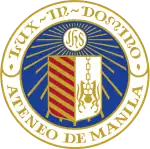 University seal[1] | |
| Latin: Universitas Athenaea Manilensis | |
Former names |
|
|---|---|
| Motto | Lux in Domino (Latin) |
Motto in English | Light in the Lord |
| Type | Private, research, non-profit, coeducational basic and higher education institution |
| Established | December 10, 1859 (161 years and 62 days) |
Religious affiliation | Roman Catholic (Jesuit) |
Academic affiliations | ACUCA AUN PAASCU IAJU AJCU-AP[2] |
| Chairman | Bernadine T. Siy |
| President | Fr. Roberto C. Yap, SJ |
Academic staff | approx. 2,470[3] |
Administrative staff | 3,015[4] |
| Students | 15,269 (university level)[3] |
| Undergraduates | 8,614[3] |
| Postgraduates | 6,655[3] |
Other students | approx. 6,500 (grade school and high school) |
| Location | Loyola Heights, Quezon City, Metro Manila, Philippines
Salcedo Village, Makati, Metro Manila, Philippines Rockwell Center, Makati, Metro Manila, Philippines Ortigas Center, Pasig, Metro Manila, Philippines 14°38′20″N 121°4′40″E |
| Campus | Urban (main campus) – 133 acres (53.8 ha) |
| Colors | Blue and White[5] |
| Nickname | Blue Eagles |
Sporting affiliations | |
| Mascot | Blue Eagle[6] |
| Website | ateneo |
The university provides instruction in both basic and higher education across eleven schools, clustered into three units. Higher education is provided by two units: the Loyola Schools, a group of four schools which provide undergraduate and graduate instruction in the arts, humanities, social sciences, natural sciences, engineering, and business management; and the Professional Schools unit, composed of four schools providing professional education in law, medicine, business, and governance. Meanwhile, the Basic Education Unit, comprising the Grade School, Junior High School, and Senior High School, provides education in the K to 12 level. The different Ateneo units' curricula are generally based on the Jesuit education tradition. This is especially pronounced in the Loyola Schools, which follows a Catholic-rooted, liberal arts core curriculum.[7] The university is also home to a number of research institutes and centers.
As of 2020, five Presidents of the Philippines, five Chief Justices of the Philippine Supreme Court, six National Artists, one National Scientist, and two Ramon Magsaysay awardees have been affiliated with the Ateneo, either as students, alumni, or faculty. The most notable among the Ateneo de Manila's alumni is José Rizal, considered the national hero of the Philippines.
The United Kingdom-based Quacquarelli Symonds (QS) currently ranks the Ateneo de Manila University in the 601–650 bracket of its World University Rankings and 135th on its Asian University Rankings.[8]
History
While Jesuit teaching efforts in Manila date back to 1595, the Ateneo de Manila University traces its founding to 1859 when the Jesuits, at the behest of Governor-General Fernándo Norzagaray y Escudero, took charge of the Escuela Municipal de Manila (transl. Municipal School of Manila), a small school for the children of Spanish residents. In 1865, its name was changed to Ateneo Municipal de Manila (transl. Municipal Athenaeum of Manila) when it became accredited as a secondary school. It began offering the bachelor's degree, as well as courses leading to certificates in agriculture, surveying, and business. When Americans occupied the Philippines in 1902, its subsidy from the city was withdrawn. In 1908, the American colonial government licensed the Ateneo's bachelor degree and certificates in various disciplines. The Ateneo campus housed other Jesuit institutions of research and learning, such as the Manila Observatory and the San Jose Major Seminary.[9] In 1909, the Jesuits removed the word "Municipal" from the school's name and it became simply the Ateneo de Manila.[10]
American Jesuits replaced their Spanish brethren in 1921. In 1932, the original campus at Intramuros in Manila was destroyed by fire and the Ateneo moved to the San Jose Major Seminary grounds in Padre Faura, Ermita. The Intramuros campus was rebuilt in 1939. The Ateneo campuses were destroyed again in World War II. The Ateneo reopened temporarily in Plaza Guipit in Sampaloc, Manila. The Padre Faura campus reopened in 1946 with Quonset huts serving as buildings among the campus ruins.[11][12] In 1952, William Masterson moved most of the Ateneo units to its present Loyola Heights campus. The Padre Faura campus continued to house the professional schools until 1976. Francisco Araneta was appointed as the Ateneo de Manila's first Filipino rector in 1958. In 1959, its centennial year, Ateneo became a university.[9]
On September 25, 1969, Pacifico Ortiz, SJ was installed as the first Filipino president of the Ateneo de Manila University.[13] At this time, the Graduate School split into the Graduate School of Arts and Sciences and what would become the Graduate School of Business. In 1968, the Ateneo co-founded the Asian Institute of Management.[14] The Ateneo college opened its doors to its first female students in 1973.[15] The Graduate School of Arts and Sciences moved to Loyola Heights in 1976, and the Padre Faura campus closed in 1977 as the Graduate School of Business and the Law School moved to Salcedo Village, Makati.[16] In February 1978, Ateneo opened what would become the Ateneo Computer Technology Center.[9]
As student activism rose in the 1970s following the proclamation of martial law by President Ferdinand Marcos, Ateneans took an active role along with student organizations from other colleges and universities.[17] On February 11, 1986, alumnus and Antique Governor Evelio Javier was shot and killed. Two weeks later, Ateneans joined thousands of Filipinos in the People Power Revolution along EDSA to oust Marcos.[18]
In 1991, the School of Law became the first law school in the Philippines to confer the Juris Doctor degree.[19] The Ateneo School of Government was established in 1996 and, in 1998, a campus housing the Ateneo Graduate School of Business, Ateneo School of Law, and the Ateneo School of Government, opened in Rockwell Center in Poblacion, Makati.[20] The Science Education Complex was also completed in the Loyola Heights campus. In 2000, the School of Arts and Sciences, consisting of the undergraduate and graduate schools, was restructured into the Loyola Schools.[21] In April 2002, the office of the university president established Pathways to Higher Education-Philippines, one of the university's outreach initiatives, with the help of the Ford and Synergeia Foundations.[22] In July 2002, the Church of the Gesù was completed in the Loyola Heights campus.[23] In 2003, the Ateneo entered into its partnership with Gawad Kalinga, its first formal, university-wide social action program.[24]
In July 2006, the Manuel V. Pangilinan Center for Student Leadership was completed.[25] The Ateneo School of Medicine and Public Health facility in Ortigas Center, Pasig welcomed its first batch of professional students in June 2007. In 2008, work on a new Rizal Library facility began[26] and a new set of university dormitories was inaugurated.[27]
Schools
Professional Schools
The Ateneo Professional Schools is the professional education unit of the Ateneo de Manila University, and comprises the following four schools: the Ateneo Graduate School of Business, which offers a variety of Master of Business Administration (MBA) concentrations, including a Master in Health Services Administration; the Ateneo School of Law, which confers the Juris Doctor (JD) and Master of Laws (LL.M.) degrees; the Ateneo School of Medicine and Public Health, opened in 2007, which offers an integrated Doctor of Medicine (M.D.) and MBA program;[28] and the Ateneo School of Government, which confers the Master in Public Management and Ph.D. in Leadership Studies degrees. The Professional Schools also confer certificates for short courses.[29]
Loyola Schools
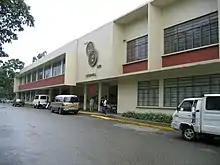
The Loyola Schools are the higher education unit of the Ateneo de Manila University since 2000, that offers undergraduate and graduate degree programs in the arts and sciences and operates under the Vice President of the university. It is located at the university's Loyola Heights campus in Katipunan, Quezon City. It confers the Bachelor of Arts, Bachelor of Science, Bachelor of Fine Arts, Master of Arts, Master of Science, and Doctor of Philosophy degrees. It is currently composed of four schools, the School of Humanities, the John Gokongwei School of Management, the School of Science and Engineering, and the School of Social Sciences. A fifth school, the School of Education and Learning Design, will be established in 2021.[30] The arrangement of the Loyola Schools academic buildings reflects its origin as a single College of Arts and Sciences.
Grade School
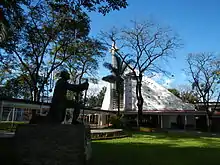

The Ateneo de Manila Grade School is the elementary education unit of the Ateneo de Manila University, and is the oldest unit in existence - Ateneo de Manila began as a government-run primary school during the Spanish colonial period. It is an all-boys school with a population of around 4,000 students.[31] The school had implemented the K-12 program since the 2013–14 academic year.[32] The Ateneo de Manila Grade School is one of the first elementary schools in the Philippines to adopt the Singapore math curriculum.[33]
Junior High School
The Ateneo de Manila Junior High School (AJHS) is the middle school unit of the Ateneo de Manila University, offering the seventh to tenth grades for male students. It was established in 2013 to comply with the Philippines' K-12 education system. It currently occupies the old Ateneo de Manila High School campus.[34]
The AJHS has utilized a house system since 2016, labeled as "support systems for formation" aimed at "intensifying the care and formation the school bestows upon its students." The AJHS is divided according to the following four clusters, named after pivotal places in the life of Saint Ignatius of Loyola: Cardoner, La Storta, Montserrat, and Pamplona. Sections from Grade levels 7-10 are divided equally and placed in their respective clusters. Each cluster has dedicated class moderators, subject teachers, guidance counselors, immersion coordinators, and staff to cater to the specific needs of the students. The cluster is led by a "cluster coordinator" (teacher) and cluster head(student), who organize a variety of activities, such as mentorships and team building. The cluster system idea came from a study of Dra. Carmela Oracion done with regards to school systems in Singapore, where results showed cluster systems benefited students more than the traditional batch systems. [35]
According to an article written by the Hi-Lites organization of the AJHS, the goals of the cluster system include the following:
1. Platform for student-centered approach for students’ total development and close monitoring of every student to meet their academic and affective needs.
2. Immediate response as a result of the simple and flattened organization, empowering the cluster, thus moving the point of decision-making closer to the students, allowing it to be better informed and be more responsive.
3. Some degree of autonomy, bringing about more bottom-up initiatives from the teachers and students, with the possibility of customized activities.
4. Increased collegiality among teachers and other personnel, with focused attention on the students
Despite offering secondary education, the AJHS offers an honors program for its English, Filipino, mathematics, and science classes. Students who choose to pursue the honors program are placed in a separate class with a more advanced program.[34]
The AJHS student body is governed by the Sanggunian ng mga Mag-aaral ng Nakababatang Mataas na Paaralang Ateneo de Manila (Sanggu-JHS; transl. Student Council of the Ateneo de Manila Junior High School). The Sanggu-JHS is led by a chairman, who is aided by a secretary-general and a finance officer, alongside four vice-chairs who supervises each branch of the Sanggu-JHS. These branches are: the Assembly of Class Officers (ACO), which involves the governance of all class officers in each section and batch; the Council of Student Organizations (CSO), which involves the governance of all officers in each student organization referred to as "villages"; and the Athletics Council (AthC), which involves the governance of all varsity team officers.[34]
The AJHS campus includes one library, the Faculty Instructional Technology Center, and a large athletics complex with one of the largest school-based covered courts facilities in the country.[36] A theater group called Dulaang Sibol, founded by longtime faculty member Onofre R. Pagsanghan in 1956, continues to operate in the AJHS/ASHS.[36]
The ASHS is also governed by its own Sanggunian ng mga Mag-aaral ng Nakababatang Mataas na Paaralang Ateneo de Manila (Sanggu-ASHS; transl. Student Council of the Ateneo de Manila Junior High School). Compared to the Sanggu-JHS, Sanggu-ASHS’s Council of Student Committees (CSC) consist of 5 Sandigan committees: Kanlaon, Matanglawin, Lakambini, Mapulon, and Alunsina, where each committee has their own advocacy, alongside the ASHS Fair Committee and BlueBook Committee.
Senior High School
The Ateneo de Manila Senior High School (ASHS) is the senior high school unit of the Ateneo de Manila University, offering the eleventh and twelfth grades since 2013 following the restructuring of the university's high school units in adherence with the national K-12 program. Since the 2016–17 academic year, the ASHS has accepted female students.[37]
The ASHS offers all four academic strands of the K-12 program (Accountancy and Business Management; Humanities and Social Sciences; Science and Technology, Engineering, and Mathematics; and the General Academic).[38] The ASHS currently occupies the new senior high school building topped off in 2016.[39]
Loyola School of Theology
The Loyola School of Theology is a Jesuit school of theology and pastoral studies, run separately from but federated with the Ateneo de Manila University. It is located in the portion of the university's Loyola Heights campus that is geographically within Marikina. The school offers baccalaureate, licentiate, and doctoral ecclesiastical degrees in theology, as well as postgraduate degrees in theological studies, theology, and pastoral ministry from the Ateneo de Manila. It also supports the theology and religious education postgraduate programs of the Ateneo Loyola Schools' Department of Theology.[40]
Campuses
Currently, the main Ateneo de Manila campus is located along Katipunan Avenue in Loyola Heights, Quezon City, Metro Manila.[41] The campus houses the Loyola Schools and the university's grade school and high schools, as well as the Loyola School of Theology. Two other campuses, in Rockwell Center and Salcedo Village, both in Makati, house the university's professional schools of business, law, and government. A fourth facility in the Don Eugenio López Sr. Medical Complex in Ortigas Center, Pasig, houses its professional school of medicine and public health.
Loyola Heights

Overlooking the Marikina Valley, the 205-acre (83.0 ha) main campus is located in Loyola Heights, along the eastern side of Katipunan Avenue, and is south of and adjacent to the campus of Miriam College. The Grade School, High School, and Loyola Schools are located in Ateneo's Loyola Heights campus. Beside the Grade School is the Henry Lee Irwin Theater, built in 1995 to house the school's formal events and productions. Complementing the old buildings of the Loyola Schools are the Science Education Complex, as well as the PLDT Convergent Technologies Center and the John Gokongwei School of Management Complex.[42] In 2018, the university inaugurated the Areté, the Ateneo's "creative hub" for visual, practical, and performing arts. The Areté houses the Ateneo Art Gallery, the Hyundai Hall (a 900-seat theater), the Doreen Gamboa Fernandez Black Box Theater, the Unionbank Ubuntu Space, and spaces for the Ateneo's collaborative degree program with Le Cordon Bleu. The Department of Fine Arts and the Ateneo Institute for the Science and Art of Learning and Teaching also hold office in the Areté.
Within the campus is the Rizal Library, the main university library. Also located here are numerous units and research centers affiliated with the Ateneo, such as the Institute of Social Order, Institute of Philippine Culture, Institute on Church and Social Issues, Asian Public Intellectuals Fellowships, the Philippine Institute for Pure and Applied Chemistry, the National Chemistry Instrumentation Center, the Jesuit Communications Foundation, the Jesuit Basic Education Commission, and others. Also situated here are the East Asian Pastoral Institute, Loyola School of Theology, and the San Jose Seminary, all Jesuit formation institutions federated with the Ateneo de Manila University. The Manila Observatory is also located on campus.[42] Its athletic facilities include the Blue Eagle Gym, also known as the Loyola Center, standing at the southern end of the campus, and the Moro Lorenzo Sports Center (MLSC) on the northern end. The Blue Eagle Gym is one of the largest gymnasiums among the universities in Metro Manila while the MLSC is often used by the Philippines men's national basketball team as well as other professional teams for their training needs.[42]
The Church of the Gesù, completed in July 2002, stands on top of the Sacred Heart Hill and overlooks the rest of the campus. The school's chapels include the St. Stanislaus Kostka Chapel and the Chapel of the First Companions in the high school, the Chapel of the Immaculate Conception in the college complex's Gonzaga Hall, the chapel at the Loyola House of Studies, and the Chapel of the Holy Guardian Angels in the grade school, among others. Two parish churches outside the campus, the Our Lady of Pentecost Parish in Varsity Hills and the Santa María della Strada Parish in Diliman, are within walking distance from the campus.[42]
The Ateneo de Manila is also home to the largest Jesuit community in the Philippines, most of whom reside at the Jesuit Residence in the Loyola Heights campus. These Jesuits are involved in teaching, administration, and research within the university and its affiliated units.[42]
Recently, the majority of the units in the Loyola Schools have been participating in the environmental initiatives started at the student organization and administrative levels. These have been grouped under the banner of the Ateneo Environmental Management Coalition, resulting in major changes in student lifestyle and resource management all over campus.[43]
- Loyola Schools
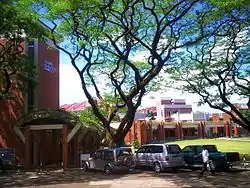 The Science Education Complex, home to the School of Science and Engineering
The Science Education Complex, home to the School of Science and Engineering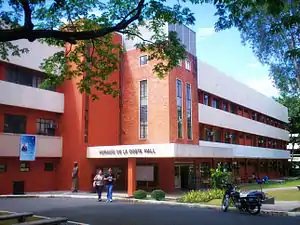 The Horacio dela Costa Hall, home to the School of Humanities
The Horacio dela Costa Hall, home to the School of Humanities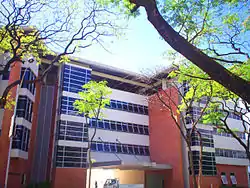 The Ricardo & Dr. Rosita Leong Hall, home to the School of Social Sciences
The Ricardo & Dr. Rosita Leong Hall, home to the School of Social Sciences The John Gokongwei School of Management
The John Gokongwei School of Management
Rockwell Center
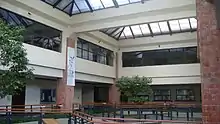
The Rockwell Center campus of the Ateneo de Manila University in Makati houses the School of Law, Graduate School of Business, School of Government, AGSB-BAP Institute of Banking, and the Ateneo Center for Continuing Education.[42] The campus was donated by the Lopez Group of Companies to the Ateneo de Manila University. It includes several research centers, a moot court facility, and the Ateneo Professional Schools Library.[42]
Salcedo Village
The Salcedo Village campus in Makati houses the different facilities of the former Ateneo Information Technology Institute and the Ateneo Center for Continuing Education. This facility formerly housed the Professional Schools prior to the completion of the Rockwell campus in 1998.[42]
Ortigas Center
The Ateneo School of Medicine and Public Health (ASMPH) at the Don Eugenio López Sr. Medical Complex in Ortigas Center, Pasig, opened its doors to its pioneering batch of students in June 2007. Beside the ASMPH is its partner hospital, The Medical City.[42]
Campus sustainability
The Ateneo de Manila University established the Ateneo Institute of Sustainability in 2013 to oversee the research and implementation of the university's sustainable development initiatives.[44] In 2014, the Ateneo launched an electric jeepney shuttle system operated by Meralco within its Loyola Heights campus to replace motorized tricycles as the means of transporting students and personnel around the campus; the Ateneo was the first educational institution in the Philippines to implement an electric jeepney transportation system.[45]
Ateneo Blue Cloud
Amidst the COVID-19 pandemic in 2020, the Ateneo de Manila University launched the Ateneo Blue Cloud (stylized AteneoBlueCloud), an online platform for the university's scholarly community. Branded as the university's "virtual campus", the Ateneo Blue Cloud hosts school curricula materials based around their framework of an "adaptive design for learning", wherein online, blended, and face-to-face educational programs are accessible by registered users.[46]
Academics
Programs
The Ateneo offers programs at the elementary, secondary, undergraduate, and graduate levels. Its academic offerings include the arts, humanities, business, law, social sciences, philosophy, theology, medicine and public health, biology, chemistry, physics, mathematics, computer science, engineering, environmental science, diplomacy, and government, with 48[47] Bachelor of Arts (AB), Bachelor of Science (BS), and Bachelor of Fine Arts (BFA) degrees at the undergraduate level. At the postgraduate level there are 76[48] Master (M), Master of Arts (MA), and Master of Science (MS) degrees; six Master of Business Administration (MBA) programs; two Master of Laws concentrations; one Master of Public Management (MPM) degree; two professional Doctor of Medicine (MD) and Juris Doctor (JD) programs, and 16 doctorate degrees. As is common in the Philippines, the primary medium of instruction is English, with a few classes taught in Filipino. Aside from teaching and research, the Ateneo de Manila also engages in social outreach. Known for its liberal arts tradition, the humanities are a key feature of Ateneo education at all levels of study.
Individual schools conduct separate admissions processes.[49] Admission into one unit in no way guarantees admission into another unit.
Undergraduate core curriculum
A key feature of the Loyola Schools is a liberal arts undergraduate core curriculum, required for all undergraduates. It includes philosophy, English and Filipino literature, theology, history, various branches of social sciences, and a community service component. The Ateneo follows the semester hour system common in American universities. Most classes are held below 40 students and student discussion is encouraged. Programs at the Loyola Schools are aimed at fostering student-centred learning.[50][51] The Ateneo was one of the first schools in the Philippines to enact a Magna Carta for undergraduates.[50][52]
Recognition and reputation
| University rankings | |
|---|---|
| Global – Overall | |
| QS World[8] | 601-650 (2021) |
| QS Employability[53] | 161-170 (2020) |
| Regional – Overall | |
| QS Asia[8] | 135 (2021) |
| National – Overall | |
| QS National[8] | 2 (2021) |
The Ateneo de Manila has been granted autonomous status by the Philippine Commission on Higher Education (CHED), granting it relative leeway in introducing new programs. It has been enjoying autonomous status since at least 2001.[54]
CHED has also accredited a number of the Ateneo de Manila's departments and programs as Centers of Excellence, indicating the highest degree of instruction, research, and extension in the Philippines of their particular fields or courses, and Centers of Development, indicating "significant improvement" of instruction, research, and extension from the previous year. The Ateneo has Centers of Excellence in information technology, chemistry, mathematics, physics, English literature, philosophy, biology, psychology, sociology, business administration or management, and entrepreneurship. It has Centers of Development in environmental science, communication, electronic engineering, history, Philippine literature, and political science.[55][56] The Loyola Heights campus also hosts three scientific research institutions: Philippine Institute of Pure and Applied Chemistry, National Chemistry Instrumentation Center, and the Manila Observatory.
The Legal Education Board has ranked the Ateneo Law School as the best performing private law school in the Philippines and the second-best overall, behind the University of the Philippines College of Law, as of 2018. Graduates of the Ateneo Law School have an average grade of 89.2 in the Philippine Bar Examination and the school has produced 23 topnotchers in history, most notably former Chief Justice Claudio Teehankee in 1940 and Supreme Court Associate Justice Arturo Brion in 1974.[57] In 2018, the Ateneo Law School had the highest passing rate for first-time examinees in the Philippine Bar Examination at 88.76%.[58]
The Ateneo School of Medicine and Public Health was ranked the best performing medical school in the Philippines by the Professional Regulation Commission in 2019, as the school had a 100% passing rate in the Philippine Physician Licensure Examination out of 133 examinees.[59]
The Ateneo grade school and high school divisions have both garnered the highest level of accreditation from the Philippine Accrediting Association of Schools, Colleges and Universities and the Federation of Accrediting Agencies of the Philippines, making it one of the top schools in the country for primary and secondary education, as of 2017.[60]
Research centers and auxiliary units
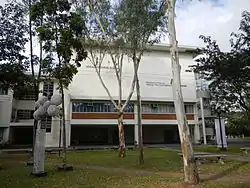

Some of the Ateneo de Manila's most active research hubs work in the fields of disaster risk reduction, prevention, and management; public education; human migration; and governance. The university houses several research centers, and has many links with industry partners, government agencies, and research networks. Some research centers, called auxiliary units, are established by the university board of trustees, while others are organized by individual schools or departments.
- Ateneo Center for Asian Studies
- Ateneo Center for Economic Research and Development
- Ateneo Center for Educational Development
- Ateneo Center for English Language Teaching
- Ateneo Center for Organisation Research and Development
- Ateneo Center for Psychological and Educational Assessment
- Ateneo Center for Social Entrepreneurship
- Ateneo Center for Social Policy and Public Affairs
- Ateneo Family Business Development Center
- Ateneo Innovation Center
- Ateneo Institute of Literary Arts and Practices
- Ateneo Java Wireless Competency Center
- Ateneo Language Learning Center
- Ateneo Macroeconomic Research Unit
- Ateneo-PLDT Advanced Network Testbed
- Ateneo Research Network for Development
- Ateneo Teacher Center
- Ateneo de Manila University Press
- Ateneo Wellness Center
- Center for Communication Research and Technology
- Center for Community Services
- Eugenio Lopez Jr. Center for Multimedia Communication
- Gaston Z. Ortigas Peace Institute
- Governor José B. Fernandez Ethics Center for Business and Public Service
- Institute of Philippine Culture
- Institute of Social Order
- Institute for Church and Social Issues
- John Gokongwei School of Management Business Accelerator
- John Gokongwei School of Management Business Resource Center
- Konrad Adenauer Asian Center for Journalism
- Manila Observatory
- National Chemistry Instrumentation Center
- Ninoy and Cory Aquino Center for Leadership
- Pathways to Higher Education-Philippines
- Philippines-Australia Studies Network
- Philippine Institute of Pure and Applied Chemistry
- Ricardo Leong Center for Chinese Studies
Journals
The Ateneo publishes the following academic journals: Kritika Kultura, Asian Perspectives in the Arts and Humanities, Budhi, Philippine Studies: Historical and Ethnographic Viewpoints, The Journal of Management for Global Sustainability, Landas, and Social Transformations: Journal of the Global South.[61]
Networks and external partnerships
The Ateneo de Manila University is a member of the following networks and academic consortia:[62]
- International
- Asia Europe Foundation
- Association of Christian Universities and Colleges in Asia
- Association of Southeast and East Asian Catholic Colleges and Universities
- Association of Universities of Asia and the Pacific
- European Studies Consortium
- Forum for East Asia-Latin America Cooperation
- Hong Kong Baptist David C. Lam Institute for East-West Studies
- Hong Kong Baptist University-Wing Lung Bank International Institute for Business Development
- International Federation of Catholic Universities
- Philippine Scholarship Award for Canadian Students
- University Mobility in Asian and the Pacific-Commission on Higher Education
- Local
- Association of Catholic Universities in the Philippines
- Catholic Educational Association of the Philippines
- Jesuit Conference for East Asia & Oceania
- Philippine Academic Consortium for Latin American Studies
- Philippine Association of Law Schools[63]
Social initiatives
The Ateneo has grounded its vision and mission in the Jesuit educational tradition of engaging with the world at large, leading the university to be involved in civic activities. Social engagement is a key part of Ateneo education, integrated into the curricula of practically all university programs.[64] Social entrepreneurship is also integrated into many of its academic programs.[65]
The Ateneo's social projects include the Ateneo-Mangyan Project for Understanding and Development to help the Mangyan indigenous group from Mindoro, the Bigay Puso and the Christian Service and Involvement Program for grade school students, and the Damay Immersion and Tulong Dunong program for senior high school students. In college, social development is fostered by programs of the Office of Social Concern and Involvement, including house-builds with the poverty alleviation movement Gawad Kalinga and the Ateneo Labor Trials Program tied into junior philosophy classes. Student organizations and offices of the Loyola Schools also operate their own social involvement programs.[64] At the Ateneo Professional Schools, programs and units like the Graduate School of Business' Mulat-Diwa, the Leaders for Health Program, and the Law School's Human Rights Center and Legal Aid programs aim to form leaders.[64] Other Ateneo initiatives include Pathways to Higher Education to help the underprivileged youth and the Ateneo Center for Educational Development which conducts national teacher and principal training programs.
The centerpiece social program of the university is its university-wide social action program in partnership with Gawad Kalinga which has helped build communities and schools in Payatas, Quezon City, in many Nueva Ecija municipalities, and three villages in the Bicol Region. The Ateneo–Gawad Kalinga partnership has also driven Kalinga Luzon, a rehabilitation effort for the victims of Typhoon Nanmadol (Yoyong); GK Youth–Ateneo, one of the largest and most active student social program of the Ateneo; Kalinga Leyte, an ongoing program which aims to provide long-term rehabilitation for the victims of the Southern Leyte landslide and Typhoon Haiyan (Yolanda), and ongoing reconstruction efforts for typhoon-stricken Bicol.[64][66]
The Ugat Foundation, an apostolate for grassroots families, is also located at the Ateneo.[67]
International collaboration
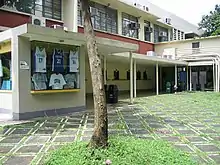
The Ateneo has international linkages with several universities, institutions, and organizations, particularly in Asia, Australasia, North and South America, and Europe. Through these cooperative efforts, the university hosts visiting faculty and research fellows from institutions abroad, and in turn, Ateneo faculty members also engage in teaching, research, and study in institutions abroad.[68][69] International cooperation also includes active student exchange through Philippine immersion programs for a month or two for small groups of 15–18 students or full study programs wherein students from partner institutions abroad take regular courses.[68]
Students of the Loyola Schools can also register for the Junior Term Abroad program, which allows them to spend a semester in one of Ateneo's partner schools for undergraduate studies.[68]
Since 2008, the Global Leadership Program was started for students from three other Catholic Jesuit universities in East Asia aside from the Ateneo: Fu Jen Catholic University in Taiwan, Sogang University in South Korea, and Sophia University in Japan.[70]
The Ateneo has partnered with several international institutions in offering certain degree programs. In 2006, the Ateneo partnered with the Sun Yat-sen University in Guangzhou to establish a Confucius Institute.[71] The institute has since offered Mandarin Chinese courses, a Masters in Teaching Chinese as a Foreign Language program, and a scholarship grant for students to study in Chinese colleges and universities.[72] Since 2018, the Ateneo Department of Information Systems and Computer Science has partnered with the Queen Mary University of London in the UK to offer a double degree Master of Science in Innovation through Media Arts Technology and Master of Science in Media and Arts Technology.[73] In 2019, the JGSOM ventured with French culinary school Le Cordon Bleu to establish the Le Cordon Bleu Ateneo de Manila Institute at the Areté, which offers a Bachelor of Science in Restaurant Entrepreneurship that adheres to requirements from Le Cordon Bleu. The institute also offers Le Cordon Bleu's Diplôme de Cuisine, Diplôme de Pâtisserie, and Grand Diplôme professional degrees at the Center for Continuing Education at the Graduate School of Business.[74] Other universities that the Ateneo has partnered with to offer joint master's degree programs are the École supérieure des sciences commerciales d'Angers in France for a Master in Management,[75] Kyushu University in Japan for a Master of Laws,[76] the Regis University in Denver for a Master of Business Administration,[77] and the University of Sydney in Australia for a Master of Human Rights and Democratization.[78]
The Ateneo collaborated with the Nippon Foundation and the University for Peace (UPEACE) in Costa Rica to initiate the Asian Peacebuilders Scholarship program. Under the program, students train to become peacebuilding practitioners for a total of eight months at the Ateneo and nine months at UPEACE, eventually receiving a Master's Degree in Transdisciplinary and Social Development from the Ateneo Department of Political Science and a Master of Arts degree from UPEACE.[79]
Libraries and museum
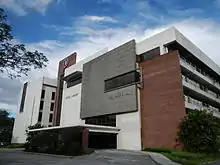
The Ateneo de Manila University has several libraries. The university's largest library is the Rizal Library, part of the Loyola Schools, located in the Loyola Heights campus.[80] The Ateneo Professional Schools Library is housed in the Professional Schools building at the Rockwell campus. The basic education units (Ateneo Grade School, Junior High School, and Senior High School) each have their own libraries; the East Asian Pastoral Institute and the Loyola School of Theology, both located inside the Loyola Heights campus, also have their own.[81] Libraries of other Jesuit universities in Naga, Zamboanga, Davao, and Cagayan de Oro are linked to the Ateneo de Manila's libraries.
The Rizal Library is divided into the Old Rizal Library and the New Rizal Library. The Old Rizal Library, which is known as the Special Collections Building, houses rare Filipiniana items including a permanent exhibit of José Rizal memorabilia, a collection of Trinidad Pardo de Tavera, the American Historical Collection containing materials related to the American colonial period, the Ateneo Library of Women's Writings, and other special collections and manuscripts by Filipino scholars, writers, and artists.[42] The New Rizal Library, a five-storey building which opened in November 2009, houses the library's circulation section, the undergraduate and graduate reserve sections, the multimedia collection, the periodicals collection, the Japanese collection, online database access terminals, an information commons, and the Library's technical services facilities.[82]
The Professional Schools Library holds one of the largest collections of materials in the fields of law, business, and government in the Philippines.[42]
Ateneo Art Gallery

The Ateneo Art Gallery is housed in the Arts Wing of the Areté. The gallery is the first museum of modern art in the Philippines, and is the only museum in the country dedicated to the collection, display, and interpretation of Philippine modern art. The heart of its collection is a large selection of post-war art donated to the university by Fernando Zóbel de Ayala.[42]
University Archives
The University Archives are housed in the Rizal Library annex building. Since 1958, it has served as the central repository of non-current records of the administrative offices, academic departments, and student organizations. Among its collections are papers and documents from key university people, relics and personal effects of alumni, some archived publications, theses, and dissertations, as well as other materials such as maps, photographs, and art work.[83]
Administration and accreditation
The Ateneo de Manila University is governed by a board of trustees currently chaired by Bernadine T. Siy.[84] A central administration, led by President of the Ateneo de Manila University Roberto Yap, oversees key initiatives related to academics, international programs, university development and alumni relations, personnel, security, and other university-wide concerns.[85] Yap succeeded Jose Ramon Villarin, on August 1, 2020.[86]
For purposes of administration, the Ateneo's schools are grouped into three units: Basic education (grade school, junior high school, and senior high school), Loyola Schools, and Professional Schools. Each unit is led by a vice president.[87] Each basic education school is led by a principal (JHS and SHS) and a headmaster (grade school);[88] meanwhile, the individual schools under the Loyola Schools and the Professional Schools are led by deans, who in turn oversee department chairs and program directors.
There are also designated vice presidents for Social Development (overseeing social initiatives);[89] University and Global Relations (overseeing internationalization and institutional linkages);[90] Finance (who also acts as the University Treasurer);[91] and Administration & Human Resources.[92]
In 2005, the academic programs of the Loyola Schools were granted a Level IV accreditation—the highest possible level—from the Commission on Higher Education through the Federation of Accrediting Agencies of the Philippines (FAAP) and the Philippine Accrediting Association of Schools, Colleges and Universities (PAASCU).[93] In 2011 it was also granted Institutional Accreditation by the same body, the first time that both citations were awarded to a university simultaneously.[94] The Ateneo de Manila is one of few universities in the country granted autonomous status by CHED, which likewise recognizes a number of the university's programs and departments as Centers of Excellence and Centers of Development. The grade school and high school divisions both have the highest level of accreditation (level III) from PAASCU and FAAP.[95]
Student life
Residence halls
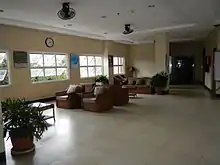
While the majority of its students live in Metro Manila, the university has four on-campus dormitories for college students: Cervini Hall, Eliazo Hall, University Dormitory, and the International Residence Hall.[96] Located near the Loyola Schools, the Cervini Hall and Eliazo Hall are the on-campus dormitories primarily aimed for freshmen and varsity students of the Ateneo de Manila University. Cervini Hall accommodates approximately two hundred male students, and neighboring Eliazo Hall houses one hundred and sixty female students. The University Dormitory, completed in 2008, houses six hundred students. Other dormitories which are also open to college and graduate school students are those of the Institute of Social Order, Arrupe International Residence, and the East Asian Pastoral Institute.[42] Those who desire to live off-campus reside in nearby accredited dormitories and condominiums along or near Katipunan Avenue, such as Oracle Residences, FBR Building, Xanland Plaza, One Burgundy Plaza, Prince David Condominium, and Berkeley Residences, sharing study and living areas with students from the University of the Philippines Diliman and Miriam College.
Most dorm activities and support services are organized and managed by the residents themselves through the Ateneo Resident Students Association (ARSA) and its working committees. These include the orientation for new and freshmen dormers; academic tutorials, group study and book lending; Sunday masses, evening prayer, and recollections; sportsfests, a variety show, and open houses. ARSA is also active in opportunities for social awareness and involvement like disaster relief operations, socio-political mobilizations, and social education.
Student organizations
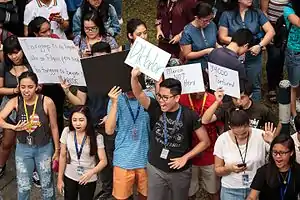
There are currently over 50 accredited college student organizations in the Loyola Schools. Among these is the Ateneo Catechetical Instruction League, founded in 1907, the oldest student organization in the Ateneo and one of the oldest in the Philippines.[97]
The Ateneo College Glee Club (ACGC) is the oldest extant university chorale in the Philippines. ACGC has participated in numerous international choral and choir competitions including the European Grand Prix for Choral Singing.[98]
The Ateneo Debate Society, the undergraduate debate organization of Ateneo, is the highest-ranking debate team in the Philippines and Asia, and often in the top 10 of the World University Debate Rankings since the mid-2000s, peaking at no. 7 in 2012. It is currently in 13th place.[99]
Apart from other special interest organizations, home organizations for respective undergraduate courses are also widespread among the Loyola Schools. Examples of such are Ateneo Psyche, originally intended for students of AB Psychology and BS Psychology but now accepting students from all courses, and Ateneo Management Association, which only accepts students of BS Management and BS Management-Honors.
The Ateneo de Manila High School's Dulaang Sibol, which began as the Ateneo High School Dramatics Society in 1955, is the oldest existing theater group in the Philippines.[100]
Notable alumni
Graduates of Ateneo de Manila include two Ramon Magsaysay awardees; and José Rizal, considered the national hero of the Philippines. Five Presidents of the Philippines are alumni or have ties with the university. The Ateneo has also been associated with five Chief Justices of the Supreme Court of the Philippines, one National Scientist of the Philippines, four National Artists of the Philippines, and two international beauty pageant winners. Aside from Rizal, several other leaders of the Propaganda Movement during the Philippine Revolution against Spain and the United States, including Juan Luna, Juan Araneta, and Gregorio del Pilar, have graduated from the university. Many of the university's alumni have been highly influential in art, design, and literature, business, civil society, entertainment, government and politics, law, media and entertainment, science and technology, and sports in the country and in the world.
See also
References
- "The Ateneo de Manila Seal". Ateneo de Manila University. Retrieved May 2, 2020.
- "Members - AJCU-AP". Association of Jesuit Colleges and Universities in Asia Pacific. Retrieved May 1, 2020.
- "Facts and Figures - Ateneo Global". Ateneo de Manila University. Retrieved May 1, 2020.
- "CBA 2019 Updates". Ateneo de Manila University. Retrieved May 1, 2020.
- "Blue And White". Ateneo de Manila University. Retrieved April 21, 2020.
- "Blue Eagle, The King". Ateneo de Manila University. Retrieved April 21, 2020.
- "The Core Curriculum". Ateneo de Manila University. Retrieved May 2, 2020.
- "Ateneo de Manila University". Quacquarelli Symonds. Retrieved November 27, 2020.
- "History". Ateneo de Manila University. Retrieved April 21, 2020.
- "History". Ateneo de Manila University. Retrieved December 6, 2020.
- Soledad S. Reyes. "From the walled city by the sea to the hill over the valley: The Ateneo through the years" The Hill. Maiden Issue. 2004.
- Jaime C. Bulatao, S.J. "Death of A University." Ateneo Alumni Guidon, Vol. VII No. I, Vol. VII No. 2, and Vol. VIII No. 1
- The Guidon October 2004
- "Historical Highlights". [c. 2008]. Asian Institute of Management. Retrieved February 13, 2010.
- Lee-Chua, Queena (September 1, 2013). "'Women for others' hold up half the sky as Ateneo marks 40 years as coed". Philippine Daily Inquirer. Retrieved April 21, 2020.
- "History of the Ateneo School of Law". Ateneo de Manila University School of Law. Retrieved April 21, 2020.
- Cristina Jayme Montiel and Susan Evangelista, eds. Down from the Hill: Ateneo de Manila In the First Ten Years Under Martial Law, 1971–1982. Ateneo de Manila University Press. 2005. ISBN 978-971-550-486-7.
- "Ateneo commemorates 30th anniversary of People Power Revolution at EDSA". Ateneo de Manila University. February 16, 2016. Retrieved April 21, 2020.
- "J.D. Curriculum". Ateneo de Manila University School of Law. Retrieved April 21, 2020.
- "History". Ateneo Graduate School of Business. 2014. Retrieved April 21, 2020.
- "The School's History". Ateneo de Manila University. Retrieved April 21, 2020.
- Abunda, Boy (August 20, 2004). "The Pathways to Higher Education". The Philippine Star. Retrieved April 21, 2020.
- Ignacio, Jose B. R. F. "The University Church of the Gesu" (PDF). Ateneo de Manila University. Retrieved April 21, 2020.
- "Gawad Kalinga". Ateneo de Manila University. December 4, 2012. Retrieved April 21, 2020.
- Ong, Eugene (June 20, 2015). "The spirit of enterprise". The Guidon. Retrieved April 21, 2020.
- "The rise of another iconic structure-the new Rizal Library". Ateneo de Manila University. Archived from the original on January 23, 2009. Retrieved May 26, 2009.
- Lolarga, Erlinda Eileen G. "A Home Away from Home: On- And Off-campus Housing For Ateneo Students". Ateneo de Manila University. Retrieved April 21, 2020.
- "Ateneo School of Medicine and Public Health (ASMPH)". Ateneo de Manila University. November 15, 2008. Retrieved March 26, 2020.
- "The Ateneo Professional Schools". Ateneo.edu. Archived from the original on June 22, 2009. Retrieved May 26, 2009.
- "Ateneo to establish School of Education and Learning Design". Ateneo de Manila University. November 26, 2020. Retrieved December 12, 2020.
- "Grade School". Ateneo de Manila University. May 15, 2012. Retrieved October 1, 2017.
- "Ateneo de Manila starts K-12 compliance by creating the Ateneo Junior High School (AJHS)". Ateneo de Manila University. April 22, 2013. Retrieved April 27, 2020.
- Lee-Chua, Queena (May 1, 2011). "Can parents help kids with math?". Philippine Daily Inquirer. Retrieved April 27, 2020.
- AJHS Planner Committee (2017). The Ateneo de Manila Junior High School Planner 2017–2018. Quezon City: Art Angel Printshop. pp. Introductory Pages.
- "AJHS launches 4 systems to intensify student care & formation | Ateneo de Manila University". Ateneo de Manila University. Retrieved April 1, 2018.
- "About the High School". Ateneo.edu. Archived from the original on June 22, 2009. Retrieved May 26, 2009.
- "Ateneo Senior High School will be co-ed in SY 2016–2017 | Ateneo de Manila University". Ateneo de Manila University. March 13, 2015. Retrieved August 6, 2017.
- "Application for Admission to Grade 11 (Senior High School)". Ateneo de Manila University. November 22, 2012. Retrieved April 1, 2018.
- "Concrete topping off ceremony held as ASHS building nears completion | Ateneo de Manila University". www.ateneo.edu. April 6, 2016. Retrieved April 1, 2018.
- "Loyola School of Theology". www.lst.edu. Retrieved August 8, 2017.
- "Campus Building Map". Ateneo de Manila University. August 22, 2013. Retrieved August 8, 2017.
- 2007 Institutional Brochure, Ateneo de Manila University. Published by the Office of International Programs, Ateneo de Manila University.
- Ruiz, Joanna. "Building the Nation: Ateneo Innovation Center Launched". Ateneo de Manila University. Retrieved April 21, 2020.
- "Ateneo Institute of Sustainability". Ateneo de Manila University. Retrieved April 30, 2020.
- Desiderio, Louella (December 23, 2014). "Ateneo launches e-jeepney shuttle". The Philippine Star. Retrieved April 30, 2020.
- Ateneo de Manila University. "Ateneo Blue Cloud". Ateneo Blue Cloud. Retrieved May 21, 2020.
- "Fields of Study". Ateneo de Manila University. Retrieved May 2, 2020.
- "Graduate Degree Programs Offered". Ateneo de Manila University. Retrieved May 2, 2020.
- "Admissions". Ateneo de Manila University. Retrieved May 5, 2020.
- Loyola Schools Undergraduate Bulletin of Information, 2003 Edition. Published by the Office of Research and Publications, Ateneo de Manila University.
- Primer on Student-Centered Learning, 2001 Edition. Published by the Office of Research and Publications, Ateneo de Manila University.
- Loyola Schools Student Handbook, 2006 Edition. Published by the Office of Research and Publications, Ateneo de Manila University.
- "QS Graduate Employability Rankings 2020". Quacquarelli Symonds. Retrieved April 27, 2020.
- "Loyola Schools programs obtain PAASCU accreditation; Ateneo conferred autonomous status anew". Ateneo de Manila University. Retrieved May 2, 2020.
- "CHED Centers of Excellence-Ateneo de Manila University". Ateneo.edu. Archived from the original on January 23, 2009. Retrieved May 26, 2009.
- "Ateneo de Manila University website". Ateneo.edu. Archived from the original on April 29, 2009. Retrieved May 26, 2009.
- "Which Law Schools Have Produced the Most Philippine Bar Topnotchers?". Esquire. May 3, 2019. Retrieved April 27, 2020.
- Brion, Arturo (September 25, 2019). "Worst law schools, 2018: Quo usque tandem abutere patientia nostra?". Manila Bulletin. Retrieved April 27, 2020.
- "Top PH medical schools based on 2019 physician licensure exams". ABS-CBN News. September 21, 2019. Retrieved April 27, 2020.
- "Ateneo de Manila University". Ateneo de Manila University. Archived from the original on October 18, 2015. Retrieved August 8, 2017.
- "Research & Publications". Ateneo de Manila University. 2006. Retrieved April 27, 2020.
- "Ateneo de Manila University Office of International Programs". Ateneo.edu. Archived from the original on January 23, 2009. Retrieved May 26, 2009.
- "蒸気自動車の歴史". Archived from the original on July 21, 2015. Retrieved July 17, 2015.
- Ateneo de Manila University President's Report 2005
- "Jesuits Teach Rich Compassion For The Poor". Newsweek. August 8, 2008. Retrieved August 18, 2008.
- "Ateneo de Manila University – Ateneo de Manila University". Retrieved July 17, 2015.
- "Ugnayan at Tulong para sa Maralitang Pamilya Foundation, Inc". Ateneo de Manila University. October 30, 2012. Retrieved August 11, 2018. Aguila, Ren (August 6, 2012). "Breaking the silence: Preventing hepatitis". GMA News Online. Retrieved August 11, 2018.
- "Ateneo de Manila Office of International Programs website". Ateneo de Manila University. July 16, 2007. Archived from the original on May 1, 2009. Retrieved May 26, 2009.
- "Ateneo chosen as campus of UN's University of Peace". The Philippine Star. April 11, 2007. Archived from the original on July 3, 2007. Retrieved June 19, 2007 – via The Nippon Foundation.
- "Global Leadership Program 2009". Sogang University. 2009. Archived from the original on December 26, 2013. Retrieved April 28, 2020.
- "Confucius Institute at Ateneo de Manila University". The People's Government of Beijing Municipality. Retrieved April 28, 2020.
- Palanca, Ellen. "The Institute". Ateneo Confucius Institute. Retrieved April 28, 2020.
- Umali, Teresa (May 31, 2018). "Philippine university to offer Master's Programs in Innovation through Media Arts Technology and Data Science". OpenGov Asia. Retrieved April 28, 2020.
- Suralta, Byle (April 12, 2019). "The Le Cordon Bleu Ateneo de Manila Institute launches "a marriage of blues"". People Asia. Retrieved April 28, 2020.
- "Partnership". Ateneo Graduate School of Business. Retrieved April 28, 2020.
- "Double Degree LL.M. Programs in Law". Kyushu University Graduate School of Law. Retrieved April 28, 2020.
- "Graduate Programs: About the Program". Ateneo Graduate School of Business. Retrieved April 28, 2020.
- "Human Rights and Democratisation". The University of Sydney. May 13, 2016. Retrieved April 28, 2020.
- "Asian Peacebuilders Scholarship". University for Peace. Retrieved April 28, 2020.
- "Rizal Library". Ateneo de Manila University. Retrieved April 28, 2020.
- "Ateneo de Manila University". Ateneo de Manila University. Retrieved August 8, 2017.
- "Ateneo Rizal Library". Rchitects Inc. Retrieved April 28, 2020.
- "University Archives". Ateneo de Manila University. Retrieved April 28, 2020.
- "Siy is new chairman of AdMU's Board of Trustees". The Manila Times. February 27, 2020. Retrieved April 28, 2020.
- "Central Administration". Ateneo de Manila University. Retrieved April 28, 2020.
- "Memo from the BOT Chair: Term Extension of University President". Ateneo de Manila University. Retrieved May 27, 2020.
- "Administration - Ateneo de Manila University". Ateneo de Manila University. Retrieved May 1, 2020.
- "Structure - Grade School". Ateneo de Manila University. Retrieved May 1, 2020.
- "Vice President for Social Development". Ateneo de Manila University. Retrieved May 1, 2020.
- "Office of the Vice President for University and Global Relations". Ateneo de Manila University. Retrieved May 1, 2020.
- "Vice President for Finance and Treasurer". Ateneo de Manila University. Retrieved May 1, 2020.
- "Vice President for Administration and Human Resources". Ateneo de Manila University. Retrieved May 1, 2020.
- The Guidon. October 2005
- "PAASCU awards Loyola Schools with Institutional Accreditation and Level IV Reaccredited status". Ateneo de Manila University. Retrieved July 17, 2015.
- "AGS gets 5-year PAASCU reaccreditation". Ateneo de Manila University. June 2, 2014. Retrieved April 28, 2020.
- http://residencehalls.ateneo.edu/life-and-community/housing/residence-halls/ateneo-residence-halls
- "ACIL". Ateneo de Manila University. Retrieved April 29, 2020.
- Medina, Andrei (May 25, 2012). "Ateneo Glee Club wins top prize at choral fest in Ireland". GMA News Online. Retrieved July 17, 2015.
- Mendoza, Sheila (February 20, 2012). "Cheers! Four PH universities in top debate societies". Yahoo News Singapore. Retrieved July 17, 2015.
- Orosa, Rosalinda (December 10, 2005). "Ateneo's Dulaang Sibol / lonesco play at FEU". The Philippine Star. Retrieved April 29, 2020.
Further reading
|
|
External links
| Wikimedia Commons has media related to Ateneo de Manila University. |

